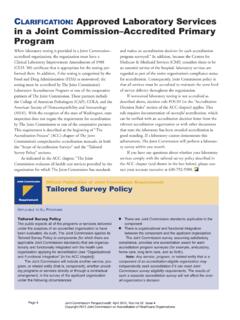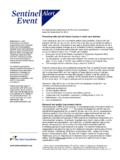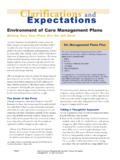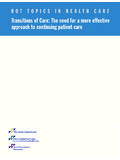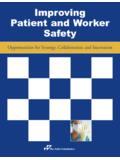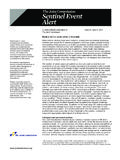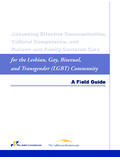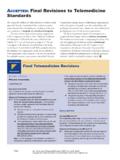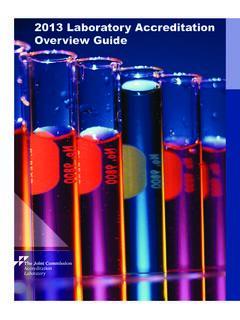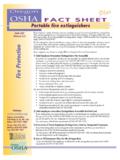Transcription of Prepublication Requirements - jointcommission.org
1 Prepublication Requirements Issued September 19, 2019 . EC Revisions for OBS. The Joint Commission has approved the following revisions for Prepublication . While revised Requirements are published in the semiannual updates to the print manuals (as well as in the online E-dition ), accredited organizations and paid subscribers can also view them in the monthly periodical The Joint Commission Perspectives . To begin your subscription, call 800-746-6578 or visit Please note: Where applicable, this report shows current standards and EPs first, with deleted language struck- through. Then, the revised requirement follows in bold text, with new language underlined. APPLICABLE TO THE OFFICE-BASED SURGERY ACCREDITATION PROGRAM. Effective January 1, 2020. Environment of Care (EC) Chapter The practice manages fire risks. Element(s) of Performance for 1. The practice minimizes the potential for harm from fire , smoke, and other products of combustion.
2 1. The practice minimizes the potential for harm from fire , smoke, and other products of combustion. Note: For additional guidance on business occupancy Requirements , see NFPA 101-2012. 4. The practice maintains free and unobstructed access to all exits. 4. The practice maintains free and unobstructed access to all exits. Note: For additional guidance on business occupancy Requirements , see NFPA 101-2012. Page 1 of 6. Prepublication Standards 2019 The Joint Commission Effective January 1, 2020. Prepublication Requirements continued September 19, 2019. The practice maintains fire safety equipment and fire safety building features. Note: This standard does not require the practice to have the types of fire safety equipment and building features described below. However, if these types of equipment or features exist within the building, then the following maintenance, testing, and inspection Requirements apply.
3 Element(s) of Performance for 2. Every 6 months, the practice tests valve tamper switches and water-flow devices. The completion date of the tests is documented. Note: For additional guidance on performing tests, see NFPA 72, 1999 edition (Table ). 2. Every 6 months, the practice tests vane-type and pressure-type water flow devices and valve tamper switches on the inventory. The results and completion dates are documented. Note 1: For additional guidance on performing tests, see NFPA 72-2010: Table Note 2: Mechanical water-flow devices (including, but not limited to, water motor gongs) should be tested quarterly. The results and completion dates are documented. (For full text, refer to NFPA 25-2011: Table ). 3. Every 12 months, the practice tests duct detectors, electromechanical releasing devices, heat detectors, manual fire alarm boxes, and smoke detectors. The completion date of the tests is documented.
4 Note: For additional guidance on performing tests, see NFPA 72, 1999 edition (Table ). 3. Every 12 months, the practice tests duct detectors, heat detectors, manual fire alarm boxes, and smoke detectors on the inventory. The results and completion dates are documented. Note: For additional guidance on performing tests, see NFPA 72-2010: Table ; 4. Every 12 months, the practice tests visual and audible fire alarms, including speakers. The completion date of the tests is documented. Note: For additional guidance on performing tests, see NFPA 72, 1999 edition (Table ). 4. Every 12 months, the practice tests visual and audible fire alarms, including speakers and door- releasing devices on the inventory. The results and completion dates are documented. Note: For additional guidance on performing tests, see NFPA 72-2010: Table 5. Every quarter, the practice tests fire alarm equipment for notifying off-site fire responders.
5 The completion date of the tests is documented. Note: For additional guidance on performing tests, see NFPA 72, 1999 edition (Table ). 5. Every 12 months, the practice tests fire alarm equipment on the inventory for notifying off-site fire responders. The results and completion dates are documented. Note: For additional guidance on performing tests, see NFPA 72-2010: Table Page 2 of 6. Prepublication Standards 2019 The Joint Commission Effective January 1, 2020. Prepublication Requirements continued September 19, 2019. 6. For automatic sprinkler systems: Every week, the practice tests fire pumps under no-flow conditions. The completion date of the tests is documented. Note 1: This element of performance applies only to office-based surgery practices that provide services or treatment that simultaneously render four or more patients incapable of taking action for self- preservation under emergency situations without the help of others.
6 Note 2: For additional guidance on performing tests, see NFPA 25, 1998 edition. 6. For automatic sprinkler systems: Every week, the practice tests fire pumps under no-flow conditions. The results and completion dates are documented. Note 1: This element of performance applies only to office-based surgery practices that provide services or treatment that simultaneously render four or more patients incapable of taking action for self-preservation under emergency situations without the help of others. Note 2: For additional guidance on performing tests, see NFPA 25-2011: ; 7. For automatic sprinkler systems: Every 6 months, the practice tests water-storage tank high- and low- water level alarms. The completion date of the tests is documented. Note: For additional guidance on performing tests, see NFPA 25, 1998 edition (Section ). 7. For automatic sprinkler systems: Every six months, the practice tests water-storage tank high- and low-water level alarms.
7 The results and completion dates are documented. Note: For additional guidance on performing tests, see NFPA 25-2011: ; Table 8. For automatic sprinkler systems: Every month during cold weather, the practice tests water-storage tank temperature alarms. The completion date of the tests is documented. Note: For additional guidance on performing tests, see NFPA 25, 1998 edition (Section 6-3). 8. For automatic sprinkler systems: Every month during cold weather, the practice tests water- storage tank temperature alarms. The results and completion dates are documented. Note: For additional guidance on performing tests, see NFPA 25-2011: ; Table 9. For automatic sprinkler systems: Every 12 months, the practice tests main drains at system low point or at all system risers. The completion date of the tests is documented. Note: For additional guidance on performing tests, see NFPA 25, 1998 edition (Section ).
8 9. For automatic sprinkler systems: Every 12 months, the practice tests main drains at system low point or at all system risers. The results and completion dates are documented. Note: For additional guidance on performing tests, see NFPA 25-2011: ; ; Table ; Table 10. For automatic sprinkler systems: Every quarter, the practice inspects all fire department water supply connections. The completion dates of the inspections are documented. Note: For additional guidance on performing tests, see NFPA 25, 1998 edition (Section ). 10. For automatic sprinkler systems: Every quarter, the practice inspects all fire department water supply connections. The results and completion dates are documented. Note: For additional guidance on performing tests, see NFPA 25-2011: ; Table Page 3 of 6. Prepublication Standards 2019 The Joint Commission Effective January 1, 2020. Prepublication Requirements continued September 19, 2019.
9 15. At least monthly, the practice inspects all portable fire extinguishers. The completion dates of the inspections are documented. Note 1: There are many ways to document the inspections, such as using bar-coding equipment, using check marks on a tag, or using an inventory. Note 2: Inspections involve a visual check for the presence and correct type of extinguisher , broken parts, full charge, and ease of access. Note 3: For additional guidance on inspection of fire extinguishers, see NFPA 10, Standard for portable fire Extinguishers, 1998 edition (Sections 1-6, 4-3, and 4-4). 15. At least monthly, the practice inspects portable fire extinguishers. The results and completion dates are documented. Note 1: There are many ways to document the inspections, such as using bar-coding equipment, using check marks on a tag, or using an inventory. Note 2: Inspections involve a visual check to determine correct type of and clear and unobstructed access to a fire extinguisher , in addition to a check for broken parts and full charge.
10 Note 3: For additional guidance on inspection of fire extinguishers, see NFPA 10-2010: ;. 16. Every 12 months, the practice performs maintenance on portable fire extinguishers. The completion date of the maintenance is documented. Note 1: There are many ways to document the maintenance, such as using bar-coding equipment, using check marks on a tag, or using an inventory. Note 2: For additional guidance on maintaining fire extinguishers, see NFPA 10, Standard for portable fire Extinguishers, 1998 edition (Sections 1-6, 4-3, and 4-4). 16. Every 12 months, the practice performs maintenance on portable fire extinguishers, including recharging. Individuals performing annual maintenance on extinguishers are certified. The results and completion dates are documented. Note 1: There are many ways to document the maintenance, such as using bar-coding equipment, using check marks on a tag, or using an inventory.
